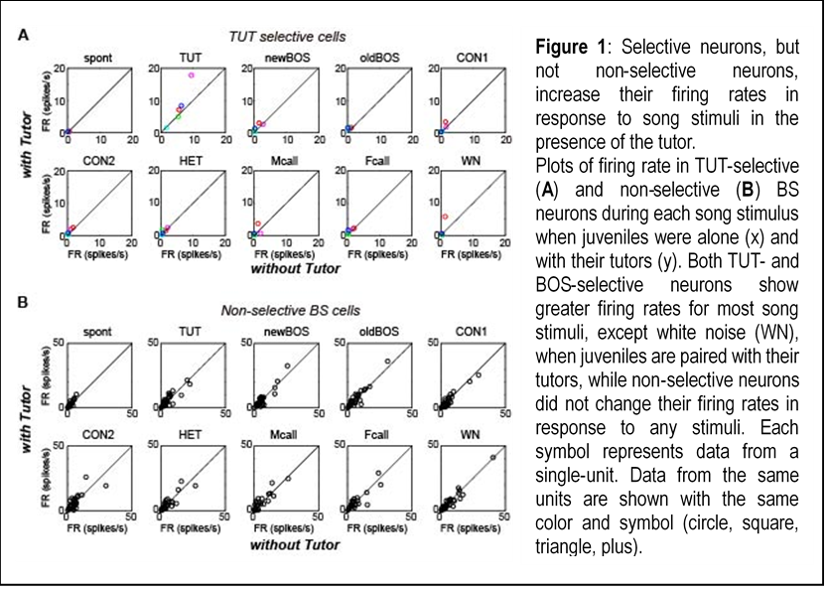FY2017 Annual Report
Neuronal Mechanism for Critical Period Unit
Associate Professor Yoko Yazaki-Sugiyama
Abstract
Songbirds learn to sing their courtship song from their tutor song experience intensively during development as humans learn to speak. Their early auditory experience shapes their brain circuits for forming a memory of tutor song, then would affect later period of motor song learning and higher cognitive functions. Our lab has been interested in how songbirds detect their own species song for song learning and how early auditory experiences shape neuronal circuits in the brain, namely how to form a memory of tutor auditory experiences. Based on the findings of last years, we tried to identify auditory neuronal circuits anatomically and physiological effect on auditory sensory activity of social interaction with tutor birds.
1. Staff
- Dr. Makoto Araki, Postdoctoral scholar
- Dr. Jelena Katic, Postdoctoral scholar
- Dr. Zachary Bell, Postdoctoral scholar (Oct 2017~)
- Dr. Takashi Kudo, Staff Scientist
- Dr. Yuichi Morohashi, Technician
2. Collaborations
2.1 GABA inhibitory control of auditory activity in zebra finch higher auditory cortical neurons
- Luke Ramegy-Healry, U Mass
2.2 Innate restriction in bird song learning
- Jon Sakata, McGill University
3. Activities and Findings
3.1 Social interaction modulating auditory neuronal activities
Songbirds are learning to sing from auditory experiences of singing of tutor birds during development. Juvenile birds intensively learn from the auditory experience through social interactions with tutors, while they learn little from passive auditory experiences, such as playback from a speaker. However, underlying neuronal mechanism for social interaction dependent song learning has yet to be elucidated. In previous years we showed that a subset of neurons in the higher-level auditory cortex of juvenile zebra finches exhibit highly selective auditory responses to the tutor song after song learning, suggesting an auditory memory trace of the experienced tutor song (Yanagihara and Yazaki-Sugiyama, 2016). We show that auditory responses of these selective neurons became greater when juveniles were paired with their tutors, while responses of non-selective neurons did not change (Fig 1). These results suggest that social interaction modulates auditory cortical activity and might function in state-dependent song learning.

3.2 Identifications of two complemental neuronal circuits for individual varieties and species identities
We have investigated how zebra finches detect their own species songs which are different between each individual and found that there are two complemental group of neurons in the brain area, called Field L, which is homologous to mammalian primary auditory cortex; One group of neurons detect temporal patterns and another group responds to acoustic features of songs. We also revealed that zebra finch juveniles learn acoustic features of song elements, while they keep silent gap temporal patterns when they are raised by Bengalese finch foster parents. In FY 2017 we further tried to identify these two group of neurons anatomically. To visualize volume of neurons we have developed tissue clearing technique and viral vectors. By combining these techniques, we visualize the anatomical structures of neurons in the primary auditory cortex anatomically and categorized them into group with their cell body shape and axon projection patterns. We are further trying identifying neurons anatomically after intracellular recording of their auditory physiological properties to match with the categorized group in volume data.
4. Publications
4.1 Journals
- Yanagihara S. and *Yazaki-Sugiyama Y. (2018) Social interaction with a tutor modulates responsiveness of specific auditory neurons in juvenile zebra finches. Behav Proc, https://doi.org/10.1016/j.beproc.2018.04.003
4.2 Books and other one-time publications
Nothing to report
4.3 Oral and Poster Presentations
- Takashi Kudo & Yoko Yazaki-Sugiyama, Early auditory experience modifies neuronal firing properties in zebra finch auditory cortex. The 40th Japanese Neuroscience Meeting
- Makoto Araki & Yoko Yazaki-Sugiyama, Parallel processing for song diversity and species identity in the zebra finch primary auditory area, The 40th Japanese Neuroscience Meeting
- Takashi Kudo & Yoko Yazaki-Sugiyama, Early auditory experience modifies neuronal firing properties in zebra finch auditory cortex, Society for Neuroscience Meeting
- Invited lecture at RIKEN BSI Summer program, Saitama Japan, July 2017
- Invited lecture at Public lecture series at the 40th annual meetings of the Japanese Neuroscience Society, Tokyo Japan, July 2017
- 1st IRCN International Symposium Learning from bird song learning: Neuronal coding of species identity in silent gaps in zebra finch songs. University of Tokyo, December 2017
- Birdsong 7: Communication in Context - The Relation Between Perception and Production”Listening to the sound of silence: Neuronal coding of species identity in the zebra finch songs. University of Maryland, USA, Nov 2017
- Symposium at 88th Annual Meeting of Zoological Society ‘動物の行動多様性を生み出す適応行動制御の神経基盤‘‘トリの歌学習における種の同一性と個の多様性を同時に担う神経基盤', Toyama Japan, Sept 2017
- Hearing Research Meeting‘Listening to the sound of silence: Neuronal coding of species identity in the zebra finch songs’, Samsung Medical center South Korea, Sept 2017
5. Intellectual Property Rights and Other Specific Achievements
Nothing to report
6. Meetings and Events
6.1 OIST Workshop: Developmental Neurobiology Course (DNC)
- Co-organized with David Van Vactor, Ichiro Masai
6.2 OIST Minisymposium: Neural Circuit Development and Function
- Co-organized with Yimin Zou (USCD), Hisashi Umemori (Harvard)
7. Other
Nothing to report.



